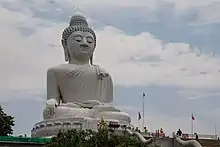Phuket Big Buddha
Phuket Big Buddha, or The Great Buddha of Phuket, is a seated Maravija Buddha statue in Phuket, Thailand. The official name is Phra Phutta Ming Mongkol Eknakiri (Thai: พระพุทธมิ่งมงคลเอกนาคคีรี; RTGS: phra phuttha ming mongkhon eknakhakhiri), shortened to Ming Mongkol Buddha. Sitting atop Nakkerd Hill (also spelt Nagakerd) near Chalong, construction began in 2004. Expansion of the base was ongoing as of 2015.[1][2] By 2017, 80 percent of the project had been completed.[3] It is the third-tallest statue in Thailand behind only the Great Buddha of Thailand and Luangpho Yai.
| พระพุทธมิ่งมงคลเอกนาคคีรี (Phra Phutta Ming Mongkol Akenakiri) | |
 The statue in 2012, before being covered with white marble | |
| Location | Wat Kitthi Sangkharam, Karon, Meaung, Phuket, Thailand |
|---|---|
| Type | Buddha statue, Maravijaya Attitude |
| Material | Concrete, covered with white marble |
| Height | 45 metres (148 ft) |
| Beginning date | 2002 |
| Completion date | 2014 |
| Dedicated to | Buddha (Guatama) |
| Website | http://www.phuket-big-buddha.com |
The Buddha statue depicts Gautama in a sitting position (Maravichai: มารวิชัย) and is 45 metres (148 feet) tall and 25.45 metres (83.5 feet) wide. It is made of concrete and covered with Burmese white marble. Facing towards Ao Chalong Bay the statue is the main Buddha of the Wat Kitthi Sankaram temple (Wat Kata). The statue was declared the "Buddhist Treasure of Phuket" by Somdet Phra Yanasangwon, the Supreme Patriarch of Thailand, in 2008.[2]
The statue cost 30 million Baht (approx. $950,000 US in February 2019),[4] sourced primarily from donations.[5] It was built legally in a national conserved forest with the approval of Thai Royal Forest Department.
Names
The statue's official name is Phra Phutta Ming Mongkol Eknakakiri (Thai: พระพุทธมิ่งมงคลเอกนาคคีรี), which means "the Cherished Auspicious Lord Buddha atop Nāga Hill." The name is a blend of native Thai, Sanskrit, and Pali words - the first element Phra Phutta (Sanskrit varabuddha) means "Lord Buddha"; the second element Ming Mongkol means "cherished and auspicious;" the third element Eknakagiri (from Sanskrit/Pali ekanāgagiri) means "atop Naga Hill."
See also
- Other tallest statues in Thailand:
- Great Buddha of Thailand, the tallest
- Luangpho Yai, the 2nd-tallest
- Luang Pho To Wat Intaravihara, the 4th-tallest
References
- Thuan, Willy (13 December 2017). "Phuket Big Buddha". Phuket 101.
- "Phuket Big Buddha Chalong Phuket Thailand". www.phuket-big-buddha.com. Retrieved 15 February 2019.
- "Phuket's finest viewpoint at the "Big Buddha"". The Nation. Retrieved 23 February 2019.
- "Country Currency Rates". countrycurrencyrates.com. Retrieved 28 February 2019.
- "Phuket Big Buddha - History & Construction of a Giant Buddha". phuket.com. Retrieved 15 February 2019.
External links
| Wikimedia Commons has media related to Big Buddha (Phuket). |